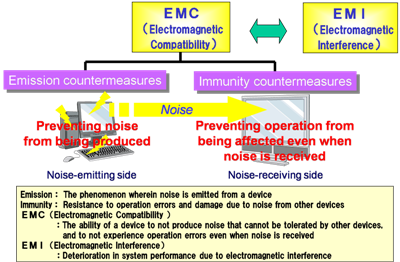[Murata Articles] Basics of Noise Countermeasures [Lesson 1] What is a…
- Writer : 최고관리자
- Date : 23-09-22 08:38
- Hit : 3,131회
본문
Fundamentals of Noise Countermeasures
<About this column>
This column aims to provide a basic explanation about noise countermeasures, from "What is EMI?" to the functions and uses of various noise countermeasure parts. This first column starts with the question, "What is an EMI filter?"
<Introduction>
"EMI" is an acronym which means Electro Magnetic Interference. Thus, an EMI filter refers to a filter used to eliminate electromagnetic interference. However, this may be a little confusing, so let's start by explaining the background of how EMI filters were created.
We are surrounded by electronic devices, and these electronic devices use digital circuits. High-frequency currents flow through digital circuits, so when these currents flow through substrate patterns, cables and other wiring, these paths become antennae and emit radio waves. When other electronic devices are nearby, these radio waves may enter the other electronic devices and produce adverse effects. For example, when a computer is placed near a radio receiver, noise may enter the radio sound. This is an example of noise generated by the digital circuits of the computer becoming radio waves which then enter the radio receiver antenna and thus, becoming noise. In addition, when strong radio waves enter a digital circuit, the digital signal waveform may change and the digital circuit may experience operation errors. The problem of noise is not only confined to radio waves conveyed through space, as noise can also occur between devices connected by power cables or other means.
Under what conditions does noise interference occur?

<How can noise issues be resolved?>
There are two different methods of resolving these noise issues. One is to prevent devices that typically produce noise from actually producing noise in the first place.. This is called emission countermeasures. The other is to implement countermeasures for the receiving-side device so that noise and operation errors do not occur even when the device receives noise. This is called immunity countermeasures. Immunity here means resistance, and immunity countermeasures consist of providing resistance to noise, like immunity to a disease, so that even when noise enters it does not cause problems. Emission countermeasures and immunity countermeasures together are referred to as EMC (Electromagnetic Compatibility) countermeasures.
Two types of noise countermeasures

In most cases, noise issues can be resolved by taking sufficient emission or immunity countermeasures. Emission countermeasures enable a pinpoint response since it is relatively easy to understand what kind of noise is being emitted and from where. However, it is much harder to predict what kind of noise will enter and from where, so immunity countermeasures are more difficult than emission countermeasures. Therefore, approaches around the world emphasize resolving noise issues by emission countermeasures. Based on this thinking, each country has established standards for resolving noise issues, and these standards state that radio waves or conduction noise of a certain level or more should not be emitted. (Some standards also require immunity performance.)
EMI filters are noise countermeasure parts used when implementing emission and immunity countermeasures, to prevent the type of electromagnetic interference (EMI) described above.
The next column will introduce approaches to noise countermeasure parts.
(source : Murata)